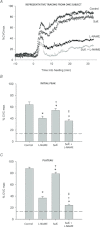KCa channels and epoxyeicosatrienoic acids: major contributors to thermal hyperaemia in human skin
- PMID: 22674719
- PMCID: PMC3547267
- DOI: 10.1113/jphysiol.2012.236398
KCa channels and epoxyeicosatrienoic acids: major contributors to thermal hyperaemia in human skin
Abstract
While it is accepted that NO is responsible for ∼60% of the plateau in cutaneous thermal hyperaemia, a large portion of the response remains unknown. We sought to determine whether the remaining ∼40% could be attributed to EDHF-mediated activation of KCa channels, and whether the epoxyeicosatrienoic acids (EETs), derived via cytochrome P450, were the predominant EDHF active in the response. Four microdialysis fibres were placed in the forearm skin of 20 subjects. In Protocol 1 (n = 10): (1) Control, (2) N(G)-nitro-l-arginine methyl ester (l-NAME), (3) a KCa channel inhibitor, tetraethylammonium (TEA), and (4) TEA + l-NAME. In Protocol 2 (n = 10): (1) Control, (2) l-NAME, (3) a cytochrome P450 inhibitor, sulfaphenazole, and (4) sulfaphenazole + l-NAME. Local heating to 42°C was performed and skin blood flow was measured with laser Doppler flowmetry. Data are presented as the percentage of maximal cutaneous vascular conductance (CVC). All drug sites attenuated plateau CVC from the control site (86 ± 1%) to 79 ± 3% with sulfaphenazole (P = 0.02 from control), 71 ± 3% with TEA (P = 0.01 from control), and further to 38 ± 2% with l-NAME (P < 0.001 from control, P < 0.001 from TEA). Plateau was largely attenuated with sulfaphenazole + l-NAME (24 ± 2%; P = 0.002 from l-NAME), and nearly abolished with l-NAME + TEA (13 ± 2%; P = 0.001 from sulfaphenazole + l-NAME), which was not different from baseline (P = 0.14). Furthermore, the initial peak was just 17 ± 2% with TEA + l-NAME (P < 0.001 from l-NAME). These data suggest EDHFs are responsible for a large portion of initial peak and the remaining 40% of the plateau phase, as administration of TEA in combination with l-NAME abolished the majority of hyperaemia. These data also suggest EETs contribute to about half of the EDHF response.
Figures


References
-
- Bellien J, Iacob M, Gutierrez L, Isabelle M, Lahary A, Thuillez C, Joannides R. Crucial role of NO and endothelium-derived hyperpolarizing factor in human sustained conduit artery flow-mediated dilatation. Hypertension. 2006;48:1088–1094. - PubMed
-
- Bellien J, Thuillez C, Joannides R. Contribution of endothelium-derived hyperpolarizing factors to the regulation of vascular tone in humans. Fundam Clin Pharmacol. 2008;22:363–377. - PubMed
-
- Bolotina VM, Najibi S, Palacino JJ, Pagano PJ, Cohen RA. Nitric oxide directly activates calcium-dependent potassium channels in vascular smooth muscle. Nature. 1994;368:850–853. - PubMed
-
- Campbell WB, Gebremedhin D, Pratt PF, Harder DR. Identification of epoxyeicosatrienoic acids as endothelium-derived hyperpolarizing factors. Circ Res. 1996;78:415–423. - PubMed
-
- Caterina MJ. Transient receptor potential ion channels as participants in thermosensation and thermoregulation. Am J Physiol Regul Integr Comp Physiol. 2007;292:R64–76. - PubMed
Publication types
MeSH terms
Substances
Grants and funding
LinkOut - more resources
Full Text Sources
Other Literature Sources

